| Program Category | 2010 | 2016 | 2022 |
|---|---|---|---|
| Health centers | ~1,100 | ~1,400 | ~1,400 |
| Sites | 8,100 | 10,400 | ~15,000 |
| Patients | 19.5 million | 25.9 million | 30.5 million |
| Funding | $2.2 billion | $5.1 billion | $5.5 billion |
The Affordable Care Act
The Affordable Care Act (ACA) was signed into law in March 2010. One of its effects was a lot more patients visiting health centers. Between 2009 and 2014, when the law was fully implemented, visits went up by 22%.
Community Health Center Fund
The ACA permanently authorized the Health Center Program. It also established a new source of mandatory funding. The Community Health Center Fund (CHCF) provided $11 billion for the program over 5 years. Combined with the program’s annual discretionary appropriation, this led to increases in BPHC’s total budget. Congress has extended the CHCF for subsequent 2- or 3-year increments several times. In 2023, it provides about two-thirds of the program’s operating budget.
More capital funding
The ACA also provided more than $1.6 billion for capital investments at health centers. With these funds, plus the program’s new operating funds and increased revenue from newly insured patients, many health centers expanded their services.
Assessing compliance with program requirements
Oversight was at the regional level during the program’s first decades. This left individual project officers and regional leadership to interpret the rules and requirements, which did not always result in consistent application.
Health Center Program Expectations
In 1996, BPHC brought all the requirements together in one place with the first version of the Health Center Program Expectations. (They were revised to their most enduring form in 1998, issued as Policy Information Notice 98-23.) The Program Expectations covered not only what was required but also what health centers should do to improve their work.
Summary of Program Requirements
In 2007, BPHC issued the Summary of Program Requirements, an effort to summarize what was truly required of health centers. The program expectations were nearly 80 pages long, while the summary was just a few pages. The summary consisted of a numbered list of requirements, with a few sentences about each one. Early versions had up to 28 items, this was soon reduced to a core set of 19 program requirements.
PINs and PALs
However, a summary could not cover everything. Throughout the 1990s and 2000s, BPHC built up a large group of policy and guidance documents. Policy Information Notices (PINs) described policies and procedures health centers were required to follow. Program Assistance Letters (PALs) explained important topics and gave recommendations. Eventually, there were dozens of PINs and PALs. It became hard to find the latest guidance on any given topic.
Health Center Program Compliance Manual
In 2017, after more than a decade of work, BPHC introduced the Health Center Program Compliance Manual. The Compliance Manual provides a step-by-step guide for health centers to understand precisely what they need to do. Each chapter describes exactly what is required in a particular area. It also describes the legal basis and what a health center must do to show compliance. The Compliance Manual replaced almost all the PINs and PALs. It became the unified source of policy guidance for the program.
Site Visit Protocol
One year later, BPHC released the Site Visit Protocol (SVP). The SVP is aligned with the chapters and sections of the Compliance Manual. It shows the precise methodology BPHC uses during operational site visits at health centers. Having the SVP makes this process clearer and more consistent, for both the bureau and the health centers.
Quality improvement efforts
During the 2010s, BPHC continued working to ensure health centers provided high-quality care. One way was by encouraging them to become Patient-Centered Medical Homes (PCMHs). BPHC also created the Quality Improvement Awards (QIAs) to encourage and reward improvement.
PCMH recognition
To be a PCMH, a health center must show commitment to patient-centered care and meet external standards for care coordination and ongoing quality improvement. The PCMH model places the focus on the patient. It emphasizes the connection between providers, patients, and their families as they work to support the patient’s needs. It also emphasizes care coordination. The doctors, nurses, therapists, social workers, and others caring for a patient must work together to ensure the patient receives complete care.
BPHC started promoting the PCMH model in 2010. Research showed that staff and patients liked it better, and it reduced costs. However, the process of getting PCMH recognition was difficult. At first, only about 1% of health centers had it.
The bureau worked with Primary Care Associations to support health centers with the transition. By 2016, 70% of health centers had PCMH recognition. The number was 78% by 2023.
Quality Improvement Awards
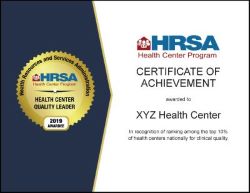
Along with funds for service expansion and capital improvement, the ACA provided resources to recognize health center quality improvements. BPHC issued the first QIAs in 2014. This was the first time funding was given to health centers for meeting quality metrics. Scores were based on the previous year’s Uniform Data System report.
The categories included:
- Use of electronic health records
- Exceeding national averages for clinical benchmarks
- Overall clinical quality
- Improvement over the previous year
Almost every health center received some type of recognition, particularly in the improvement category. Those with the highest performance received the most funding.
BPHC released another round of QIAs in 2015 and further rounds each year through 2020. Total amounts were over $100 million each time.
New categories included:
- Seeing more patients
- Cost efficiency
- Health information technology
- Reducing health disparities
- PCMH recognition
Strategic planning and reorganization
BPHC has undergone many changes over time. New branches, divisions, and offices have come and gone, and new strategies for distributing work have been tried.
BPHC 2.0
In 2015, BPHC created the Office of Strategic Business Operations to provide communications, information technology, and staff training and development support for the rest of the bureau. BPHC grew from about 300 full-time employees in 2015 to more than 400 in 2017.
BPHC REACH
Beginning in October 2018, the bureau launched a new effort to consider where the program should be in the next few years. This project became known as “BPHC REACH” (Reaching for Excellence, Advancing Community Health). The results of BPHC REACH included new divisions focused on innovation and data. But the biggest change involved the project officer role and the two large offices where most project officers worked.
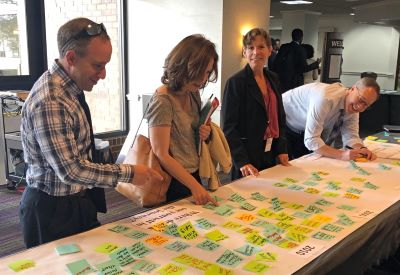
New roles for project officers
The program had always relied on project officers who worked with particular health centers. Each project officer provided most of the input and oversight for their health centers. The project officers were organized by geography. One office handled all the health centers in the north, while the other managed health centers in the south. In August 2021, this structure was changed. BPHC created new Health Center Investment Oversight and Health Center Program Monitoring offices, and the project officers took on new roles.
Rather than generalists, project officers became specialists in one type of funding or one area of monitoring. Rather than trying to learn about every part of the program, this meant they could focus and become experts. They could provide better customer service to health centers. It also meant the program could work towards higher goals like improving health outcomes and reducing health disparities.
COVID-19
The Health Center Program would prove to be one of the central planks in the nation’s response to COVID-19. Health centers provided essential care for those most at-risk from the disease. The work of health centers, partners, and HRSA and BPHC saved many lives. But in mid-March 2020, all of that lay ahead.
The initial COVID-19 response
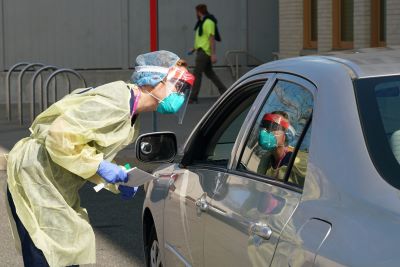
In the first days of the response, BPHC leadership began holding multiple calls each day with office directors and other key staff. By mid-April 2020, BPHC had organized 40 staff into six teams. Each handled a different aspect of the COVID-19 response. They reported on their activities at twice-daily Incident Command calls.
Others in the bureau took up the slack for colleagues who were now focused solely on COVID-19. The need to ensure that health centers provided high-quality care had not gone away. In fact, it was more urgent than ever. The pace of work was quick, the pressure was intense, and burnout was an ever-present risk. In response, the bureau increased its capacity. It grew from about 430 full time employees at the start of the pandemic to more than 480 by the summer of 2021. The number passed 500 in the fall of 2023.
The Health Center COVID-19 Survey
To better understand what was happening at health centers, BPHC launched a voluntary weekly survey in April 2020. Health centers reported on their tests, virtual visits, site closures, staff who tested positive, and their need for personal protective equipment or other supplies.
The survey gave a critical view of the impact of COVID-19 on health care facilities across the country. Other parts of the government asked HRSA for frequent updates on the data from this survey.
Emergency funding
Because of the sudden drop in patient visits, health centers faced acute funding shortfalls. HRSA was able to blunt the impact with emergency funds. Health centers received $100 million on March 24, followed by another $1.3 billion on April 8. The third round totaled $600 million, which went to both health centers and, for the first time, look-alikes. For perspective, the original total appropriation for the program in Fiscal Year 2020 had been $5.6 billion.
With this support, health centers weathered the first months of the pandemic. The next challenge was tracking the spread of the virus and protecting patients from harm.
COVID-19 testing
By May 2020, 90% of health centers provided testing. About two-thirds of these provided walk-up or drive-through testing. Health centers provided a crucial source of COVID-19 testing at a time when it was not easy to find a test.
Contact tracing
Health centers also played an important role in contact tracing. This is the work of finding people who were exposed so they can be tested and start to quarantine. Because patients trust their health centers, they were more likely to share personal information about their contacts.
Treating and preventing the virus
Monoclonal antibodies became available in the fall of 2020. Health centers were among the first to offer the treatment. The first vaccines became available in December 2020 and health centers were chosen to spearhead their delivery to underserved communities. Health centers were among the first to vaccinate their staff and their most impacted patients in January 2021. Then in February 2021, HRSA launched the Health Center COVID-19 Vaccine Program.
The Health Center COVID-19 Vaccine Program
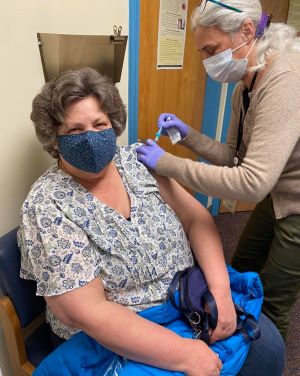
The Vaccine Program started small, with a pilot group of 250 health centers in its first month. In March 2021, the program expanded to an additional 700 health centers. In April 2021, it opened to all health centers and look-alikes. Health centers could get vaccine directly from HRSA, to add to the vaccine they got from their states or jurisdictions.
Through the spring and summer of 2021, vaccine supplies across the country remained low. The Health Center COVID-19 Vaccine Program made sure that vaccine was directed to those who needed it most. This included people experiencing homelessness, residents of public housing, migratory and seasonal agriculture workers, older adults, those with low income, racial and ethnic minorities, and all the others who rely on health centers for their care.
Many health centers held community events. Bobbi Ryder, former director of the National Center for Farmworker Health, received her vaccine at a health center she had helped establish in San Antonio, Texas. She recalls: “I was so proud I could have burst. They had the whole thing set up in the parking lot. They had nurses and medical assistants going from car to car, administering vaccines through the car windows. The only thing they were lacking was roller skates.”
Recovering from the pandemic
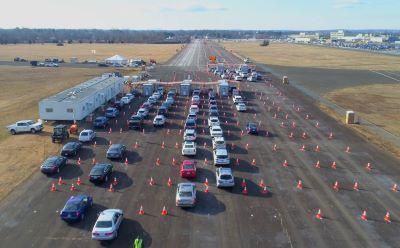
In April 2021, HRSA distributed $6.1 billion in American Rescue Plan Act funding for health centers. This was followed in July by $144 million in American Rescue Plan Act funding for look-alikes. Then, in September, HRSA awarded nearly $1 billion in additional capital funding for health centers. For context, the Health Center Program’s original total appropriation for 2021 was just under $5.7 billion.
HRSA launched new programs in late 2021 and early 2022 to provide free at-home self-testing supplies and high-quality face masks for health centers to distribute. The agency also launched a program to provide health centers with oral antiviral treatments. These programs helped blunt the later waves of the pandemic.
The Vaccine Program ended in August 2023. It had provided nearly 15.3 million vaccine doses for the nation’s underserved. Including vaccines received from all sources, health centers administered more than 24 million total doses by the end of 2023.
Finding a new normal
The Health Center Program changed during the pandemic in some ways that seem likely to stay. For example, BPHC began to conduct virtual OSVs. This involved reviewing documents electronically and talking with health center leadership and staff via teleconference. The process proved so successful, the bureau continues to use it in some cases, even as in-person visits have resumed.
With the experience gained during the pandemic and with the capital investments made through the American Rescue Plan Act, health centers are poised to flourish in the coming years as the nation continues to recover from the effects of COVID-19.
